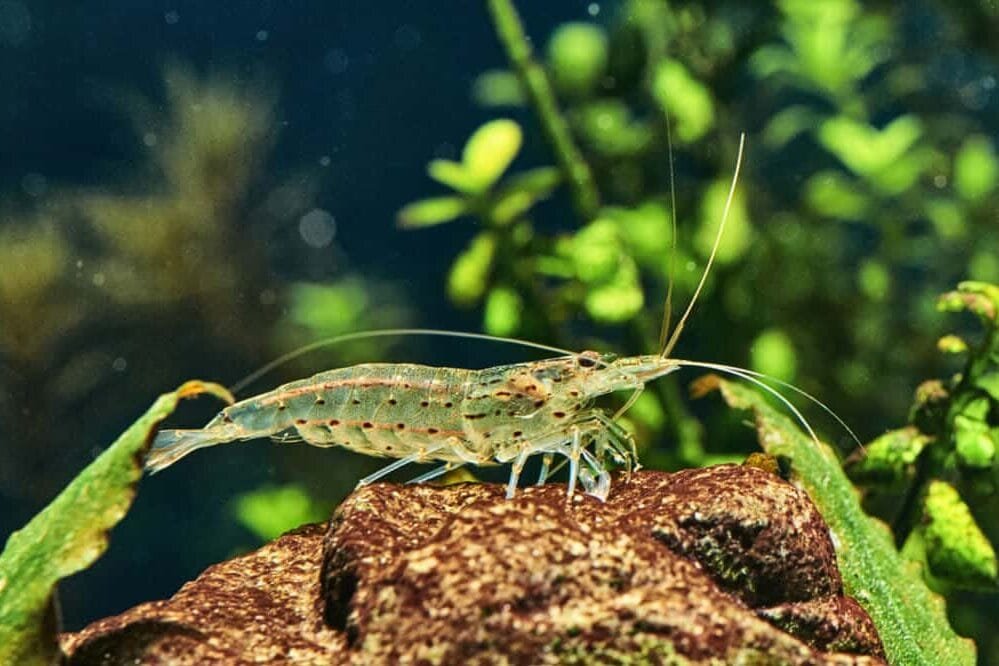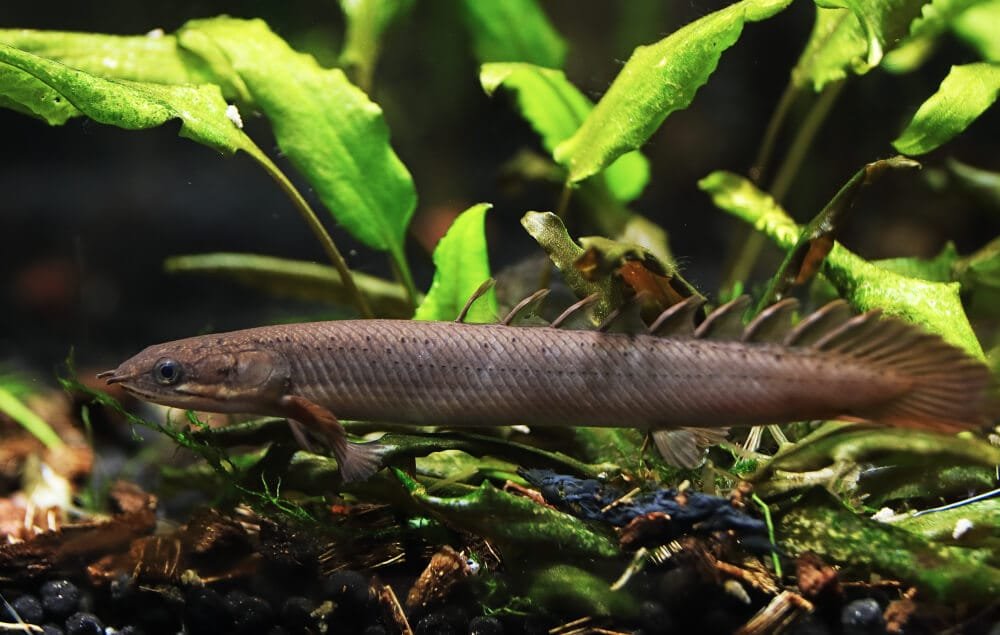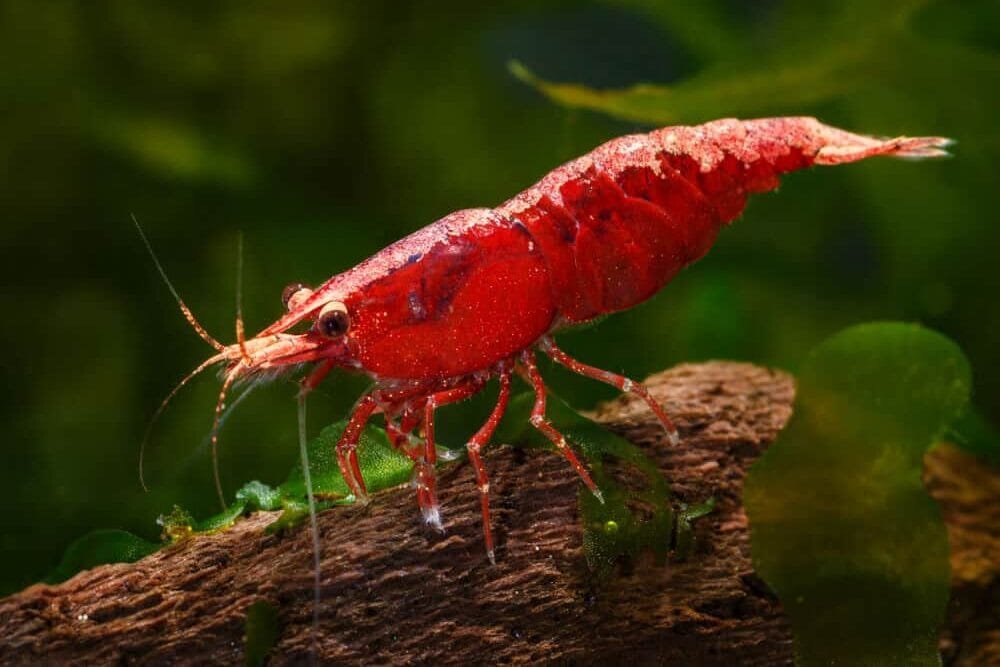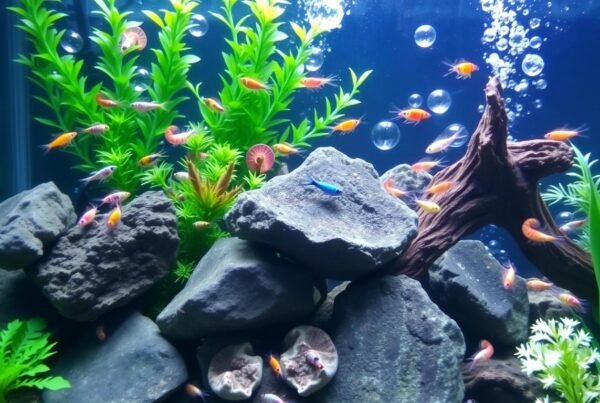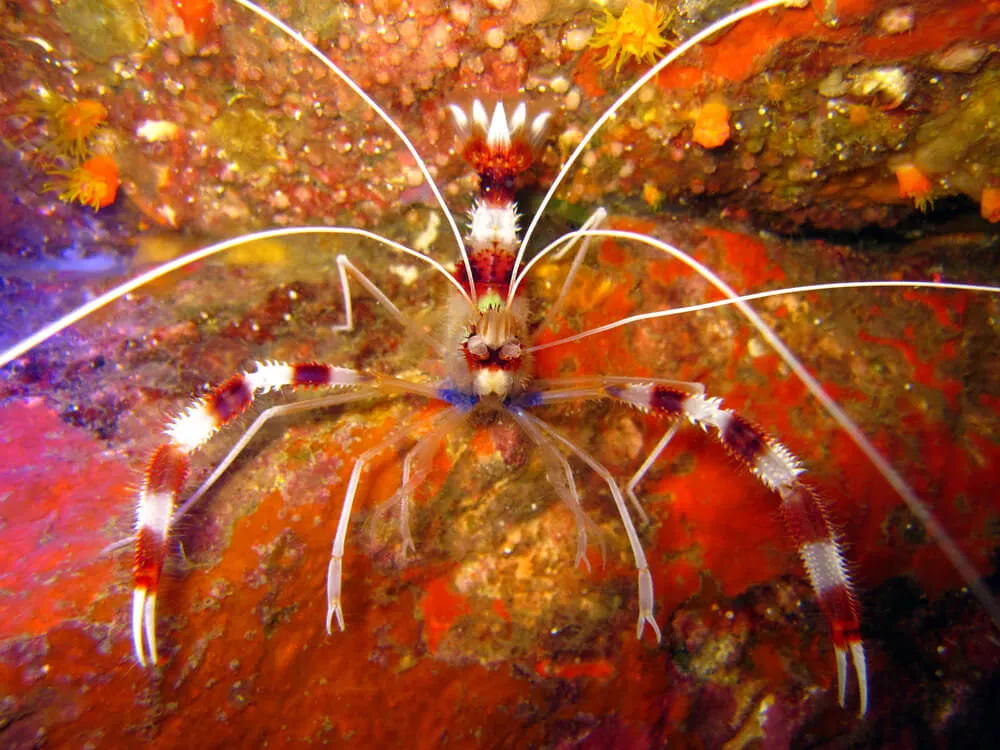When looking for Amano shrimp tank mates, you must be careful as they tend to be at their best when kept with their species. However, if you want to add variations to the tank, limit the choices to small to medium-sized peaceful community fishes.
Amano shrimp will thrive harmoniously with invertebrates, such as ghost shrimp and freshwater snails. You may also want to include Amano shrimp tank mates options algae-eating fish, including neon tetras and cherry barb.
Despite other people’s fear of the two not getting along, your Amano shrimp will thrive with bettas as long as the aquarium’s conditions benefit both species.
Overview Of The Amano Shrimp
Size: 2 Inches
Min Tank Size: 10 Gallons
Temperament: Peaceful
Diet: Omnivore
Care Level: Easy
Water Temperature: 70°F – 80°F
It’s important to understand the traits of the species before deciding on the other creatures you will add to the tank. It’s a freshwater shrimp native to Japan.
Amano shrimp are highly popular and widely among aquarium enthusiasts. They are relatively easy to care for, but like most other invertebrates, they have special requirements to live longer.
For one, they do not like strong currents in their tanks and prefer still water instead of moving water. They make a beautiful addition to any tank and are easy to keep and breed.
This shrimp species must be placed in a tank with at least ten gallons of water. While you can keep more than one Amano in a tank, putting two male shrimps together is not recommended because they tend to fight.
Keeping the water temperature at around 70 to 80 degrees Fahrenheit is also crucial. Ensure that you don’t overcrowd the tank when breeding because too many of them in the same space can lead to stunted growth or death from malnutrition.
Top 6 Amano Shrimp Tank Mates
1. Neon Tetras
Size: 1–1.5 inches
Minimum Tank Size: 10 gallons
Temperament: Peaceful
Diet: Omnivorous
Care Level: Easy
Water temperature: 72°-76°F

Neon tetras are native to South America and live in clear waters with dense vegetation. They can be kept in planted aquariums or any tank with plenty of shelter and oxygen.
They are small, schooling fish that come in a variety of colors. They’ve been sold as Glo-Lite tetras and black neon tetras, but they’re all the same species.
The fish only grows up to two inches in length. They have a five-year lifespan, making them a good choice for the beginner aquarist.
The name “neon tetra” refers to their bright red coloring when they’re stressed or frightened. Their bodies are usually silver or yellowish, with dark stripes running along their sides.
This coloration makes them easy to spot when they dart away from predators like piranhas or larger fish looking for an easy meal.
The Tetras are generally peaceful and can be kept with other small fish and some invertebrates. They will thrive in schools or six or more but will find it hard to survive when raised on their own.
They are hardy fish, meaning they are easy to maintain in home aquariums. They eat all kinds of flake, frozen and live foods such as brine shrimp, bloodworms, and daphnia.
The Tetras also do well in community tanks and can handle fluctuations in water conditions better than some other tropical fish. However, their delicate fins can get torn if you’re not careful when netting them out of your tank or moving them between tanks.
Neon Tetras make excellent companions for Amano shrimp because they share similar temperaments. They also have similar water requirements.
Many hobbyists recommend the combo of Tetras and shrimps since they adjust well and won’t eat each other.
2. Cherry Barb
Size: 1–2inches
Minimum Tank Size: 25gallons
Temperament: Peaceful
Diet: Omnivorous
Care Level: Easy
Water temperature: 73°-81°F

The Cherry Barb is native to South East Asia. This species has been introduced into other areas by man and can be found in many different countries across the globe, including America, Australia, and Europe.
It is one of the most popular freshwater aquarium fish species. It is a dwarf barb known as Red Cherry Barb, Dwarf Barb, Red Barb, and Redline Barb.
The fish is a very active swimmer that requires an aquarium with plenty of room to swim around. It comes in a wide range of colors depending on where it comes from and what type of food it has been fed.
They typically come in colors such as red, brown, grey, black, and white. The coloration can change quite dramatically depending on their diet and environment.
The species are known to be lively, active, and intelligent. However, they can be pretty territorial when kept in small groups.
They do best when kept in larger numbers and with other types of fish that are similar in size. Cherry barbs are known to be fin nippers and may cause damage to other fish if they feel threatened by them.
Cherry barb fish will breed easily in an aquarium setting with the right conditions. The female will lay up to 200 eggs at a time which will hatch within 24 hours of being laid.
The fry will stay in the nest for about two weeks before feeding on newly hatched brine shrimp, crushed flake foods, and live foods such as black worms or Daphnia Magna (water fleas). They grow quickly and reach maturity within about six months of hatching, at which point they will start spawning themselves.
Cherry Barbs are one of the easiest species to keep because they do not require any special lighting or feeding requirements beyond what is normally given in an aquarium setting.
Their peaceful trait makes them an ideal tank mate for Amano shrimps. You are assured that the two species won’t fight or eat each other.
3. Cardinal Tetra
Size: 2inches
Minimum Tank Size: 20 gallons
Temperament: Peaceful
Diet: Omnivorous
Care Level: Easy
Water temperature: 73°-81°F

The Cardinal tetra is a popular aquarium fish named for its bright red coloration. It has a bright red body and black stripe running from the gills to the tail.
The male is more vibrant in color than the female, but both sexes have this characteristic pattern. This species is native to the Amazon basin in South America.
Cardinal Tetras thrive in slow-moving water of ponds and streams. They can live at a pH level of 4.6 to 6.2 with a temperature of around 73 to 81 degrees Fahrenheit.
In an aquarium environment, the fish needs plenty of room to swim and hiding places since they are naturally shy. They should not be kept with large or aggressive tank mates because they easily get stressed out, which can lead to illness or even death.
Cardinal Tetras are hardy fish, making them ideal for beginning aquarists since they are low-maintenance. Each Tetra requires at least five gallons of water, so your tank needs to have at least 20 gallons of water if you want to keep multiple fish of this kind together.
Cardinal Tetras are generally peaceful and can be kept with other small fish, although they do prefer to be kept in schools of six or more of their own kind. They can reach up to three inches long but are usually less than two inches when sold as juveniles.
Cardinal Tetras are omnivores that eat both plant matter and animal matter in the wild. In an aquarium setting, they should be fed a variety of high-quality flake foods along with freeze-dried bloodworms or brine shrimp.
Their peaceful trait makes them a good companion to Amano shrimp. Despite being bigger than Neon Tetras, the Cardinal Tetras won’t feed on your Amanos.
4. Guppies
Size: 2 inches
Minimum Tank Size: 10 gallons
Temperament: Peaceful
Diet: Omnivorous
Care Level: Easy
Water temperature: 70°-84°F

Guppies are small, colorful, and easy-to-keep fish species that are relatively inexpensive, making them ideal for beginner aquarium hobbyists. They are freshwater fish of the Poeciliidae family.
Guppies are native to the rivers of northern South America, but they can now be found in tropical freshwater habitats all over the globe. They are one of the most popular aquarium fish due to their vibrant colors and peaceful nature.
Guppies are small, reaching a maximum length of two to four inches. Their bodies taper towards the tail, giving them a streamlined appearance, which helps them navigate through currents in their habitat.
The tail is also used for swimming. They also use their tails when steering and navigating obstacles in their environments, such as plants or rocks. They have been bred into different varieties with varying body shapes and finnage.
Some varieties have long flowing fins, while others have short fins that barely reach past their body. The coloration of guppies can also vary significantly from wild type yellow and even red.
Guppies are not picky about their water conditions but prefer temperatures between 70 – 84°F. They need lots of hiding spaces, so make sure you provide plenty of caves and plants in your tank.
Guppies can thrive in groups or alone. However, keeping guppies with other species that might eat them is not a good idea, such as large, aggressive, or territorial fish like barbs. Some cichlid species are safe to keep with guppies, although they may view them as food rather than companionship.
You can keep them in the same tank as your Amano shrimp. However, bear in mind that shrimps are considered food for guppies, but they are down the line of their food chain.
To be safe, choose small to medium-sized guppies as tank mates for Amano shrimp.
5. Ghost Shrimp
Size: 1.5 inches
Minimum Tank Size: 10 gallons
Temperament: Peaceful
Diet: Omnivorous
Care Level: Easy
Water temperature: 65–82°F

Ghost shrimp have been popular with aquarium hobbyists for many years due to their ease of care. They are named after their transparent body coloration, which allows you to see right through them.
They have a translucent appearance that makes them very easy to see in the tank. They are native to Asia and can now be found in pet stores worldwide.
Ghost shrimp are not nearly as aggressive as other shrimp species, making them ideal for community tanks with tiny fish, including Amano shrimp.
They can live about one year in captivity, but some of these species have lived up to two years or more. Their lifespan depends on the water conditions and how you look after them.
They are naturally sociable and need to be kept in groups of at least three or more. When you keep only two of the shrimp in a tank, they may likely fight and feed on each other.
The more ghost shrimp you have in the tank, the better they will behave towards one another. They can sometimes be aggressive towards other fish, a problem you won’t experience when you keep them in large schools.
Ghost shrimp are omnivores, so they will feed on almost anything in your tank, including algae and leftover food. The main staple of their diet should be spirulina algae wafers or pellets, which are readily available at most pet stores.
However, keeping enough algae in the tank will do if you don’t want to purchase special food for your ghost shrimp.
6. Freshwater Snails

Freshwater snails add great beauty, color, and attraction to the tank. Apart from their appearance, snails are natural scavengers and will clean up algae, uneaten food, and other waste accumulated in the tank.
Freshwater snails are also called aquatic snails or water snails. Freshwater snails can breathe through their skin, so they don’t need to come out of the water to breathe as most aquatic animals do.
Most snails can be kept in a simple aquarium setup with minimal maintenance. Take note that they need gravel substrate, not sand.
Sand will clog up their digestive system causing them to die within weeks. If you plan on using sand as substrate, make sure they have no sharp edges so they won’t get hurt when crawling through them.
When it comes to freshwater snails, the best companions for your Amano shrimp include Mystery Snail, Ramshorn Snail, and Nerite Snail. They will get along well, and your Amanos will feed on the leftover food the snails leave behind.
What Do Amano Shrimp Like In Their Tank?
Amano shrimp are freshwater shrimp that live in a natural environment with many plants and algae. These plants will help filter the water and reduce the nitrates to keep the tank healthy for your shrimp.
However, it is only the adult shrimps that live in freshwater. Larvae hatch and survive in brackish waters and only seek fresh river waters once they mature.
This is something that you need to take into consideration when setting up your tank. You have to plan it out and ensure that the aquarium has many shelters where the shrimps can go to seek comfort.
Amano shrimp thrive in water with a pH between 6.5 and 7.5, with temperatures between 70°F and 80°F. They prefer soft water over hard water, which means they are more likely to survive in your aquarium if you use RO/DI or distilled water instead of tap water.
Ensure that the water’s current is moving moderately and well circulated. For the substrate, you can try to copy the river beds in Japan by adding pebbles and small rocks.
You can add shrimp tubes and wooden branches to the tank to give your Amano shrimp more hiding spots. You may also want to add plants, including Green Cabomba and Java Moss.
This shrimp species thrive in an environment with algae and debris. This is why placing them in established tanks is recommended, since newly cycled tanks won’t have algae.
Does Amano Shrimp Add Bioload?
With only ten legs and a small size, Amanos won’t have any problem cleaning their nooks and crooks. They feed on algae and other food particles in your aquarium.
The shrimp help clean leftover food that may have fallen to the bottom of the tank and can cause nitrate build-up if not regularly cleaned. However, they also produce waste that needs to be cleaned out of the tank every once in a while.
They only add a trivial amount of bioload to the tank. It is recommended to keep one Amano shrimp for every five liters of water.
Will Amano Shrimp Climb Out Of Tank?
Despite being aquatic animals, Amano shrimps typically climb out of the tank when stressed. This is why choosing the best Amano shrimp tank mates is important.
Aggressive tank mates will stress the shrimps, especially when the other creatures try to eat or bully them.
Water irregularities can also cause stress to your Amanos. Many aquarists choose to keep the top of the tank open to allow natural light to come in and keep the water temperature stable.
You can opt to put a glass lid on top if you are continuously losing your shrimps. However, the lid will reduce the natural light by 15 percent.
Always check the water’s oxygen and pH levels. You must also ensure that your shrimps have many hiding places in the tank where they can go when they are feeling stressed.
Why Are My Amano Shrimp Trying To Escape?
Amano shrimps are sensitive to their tank mates and water conditions. They tend to escape when they feel threatened, stressed, or uncomfortable.
Too much light and injecting too much C02 can also prompt the shrimps to escape from the tank. However, some aquarists who have experienced keeping Amano shrimps will tell you that it’s normal for these creatures to escape occasionally, even without any reason.
However, the shrimps can survive out of the water for 15 minutes or more. Many of them get to live despite the absence of water for hours.
It all depends on the room’s humidity level and temperature. They will live for hours in a room with high levels of humidity.
On the other hand, they will die within minutes without water if the temperature outside of the tank is high. They will eventually dry, causing their death.
Do Amano Shrimp Come Out At Night?
Freshwater shrimps, including Amano, are not nocturnal or shy despite popular beliefs. They only seek hiding spots when placed in a new environment or introduced to new tank mates.
They will become more active at night when the other creatures in the tank are inactive. They are only taking their time to get acquainted with the other creatures in the tank and get used to the environment.
Once they have gotten used to the setup, the shrimps will be more comfortable moving around. You will eventually find them scavenging for algae and swimming during the day and night.
Conclusion
Amanos are freshwater shrimp native to Japan. They are popular among aquarium hobbyists because they are low-maintenance.
However, they are sensitive to the water’s condition and tend to escape the tank when feeling uncomfortable. Aside from water irregularities, they also feel stressed out by tank mates that bully or try to eat them.
Ideally, you need to keep them in a tank with at least ten gallons of water. They also don’t get along well with other male Amanos, so it is best to keep them with the females and other fish species.
Amanos take their time to get acquainted with new species in the tank and new environment. This is why they are often mistaken for being nocturnal since they are more active at night.
But once they get comfortable with their environment, you will see them swimming and cleaning the tank day and night. To prevent stressing the creature, you have to find the most suitable Amano shrimp tank mates.
Among the best companions for your Amanos include Neon Tetras, Cherry Barb, Cardinal Tetra, Guppies, Ghost Shrimp, and freshwater snails.
Remember, you don’t have to add all the species listed to the tank with your Amano shrimp. You can begin with one or two until you are certain that the species you are adding get along well with the shrimps.
